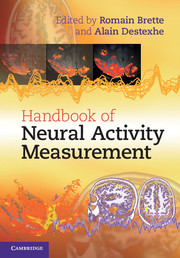Book contents
- Frontmatter
- Contents
- List of contributors
- 1 Introduction
- 2 Electrodes
- 3 Intracellular recording
- 4 Extracellular spikes and CSD
- 5 Local field potentials
- 6 EEG and MEG: forward modeling
- 7 MEG and EEG: source estimation
- 8 Intrinsic signal optical imaging
- 9 Voltage-sensitive dye imaging
- 10 Calcium imaging
- 11 Functional magnetic resonance imaging
- 12 Perspectives
- Plate section
- References
3 - Intracellular recording
Published online by Cambridge University Press: 05 October 2012
- Frontmatter
- Contents
- List of contributors
- 1 Introduction
- 2 Electrodes
- 3 Intracellular recording
- 4 Extracellular spikes and CSD
- 5 Local field potentials
- 6 EEG and MEG: forward modeling
- 7 MEG and EEG: source estimation
- 8 Intrinsic signal optical imaging
- 9 Voltage-sensitive dye imaging
- 10 Calcium imaging
- 11 Functional magnetic resonance imaging
- 12 Perspectives
- Plate section
- References
Summary
Introduction
Intracellular recording is the measurement of voltage or current across the membrane of a cell. It typically involves an electrode inserted in the cell and a reference electrode outside the cell. The electrodes are connected to an amplifier to measure the membrane potential, possibly in response to a current injected through the intracellular electrode (current clamp), or the current flowing through the intracellular electrode when the membrane potential is held at a fixed value (voltage clamp). Ionic and synaptic conductances can be measured indirectly with these two basic recording modes. While spike trains can be recorded with extracellular electrodes (see Chapter 4), subthreshold events in single neurons can only be recorded with intracellular electrodes. Intracellular recordings have been used for many applications: measuring membrane potential distribution in vivo (DeWeese et al., 2003), membrane potential correlations between neurons (Lampl et al., 1999), changes in effective membrane time constant with network activity (Pare et al., 1998; Leger et al., 2005), excitatory and inhibitory synaptic conductances in response to visual stimulation (Borg-Graham et al., 1998; Anderson et al., 2000; Monier et al., 2003), current–voltage relationships during spiking activity (Badel et al., 2008), the reproducibility of neuron responses (Mainen and Sejnowski, 1995) dendritic computation mechanisms (Stuart et al., 1999), gating mechanisms in thalamocortical circuits (Bal and McCormick, 1996), oscillations of membrane potential (Engel et al., 2001; Volgushev et al., 2002), stimulus-dependent modulation of the spike threshold (Azouz and Gray, 1999; Henze and Buzsaki, 2001; Wilent and Contreras, 2005), and many others.
- Type
- Chapter
- Information
- Handbook of Neural Activity Measurement , pp. 44 - 91Publisher: Cambridge University PressPrint publication year: 2012
References
- 10
- Cited by

